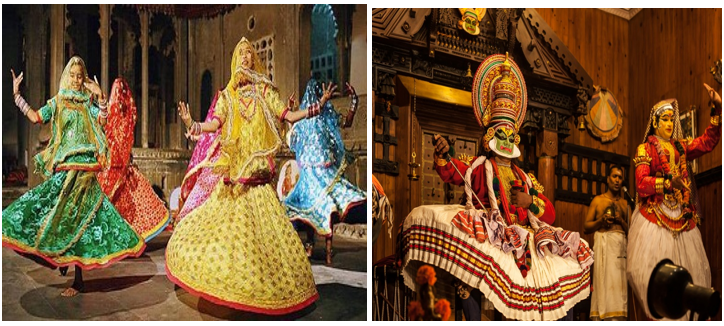Dance has always been an intricate component of religion and culture in India. According to Indian Hindu mythology, dance is believed to have been conceived by Brahma. Brahma inspired the sage Bharata Muni to write the Natya Shastra, a treatise on performing arts, from which a codified practice of dance and drama emerged. India is considered to be the origin country of Dance, which has provided vivid rich cultural heritage as diversification is the identity of the country.
In India, dance forms have originated from different parts of India as per the local tradition. These dance forms have evolved and incorporated new dimensions with passage of the time. In this article, GS SCORE is highlight the various Indian dance forms- classical and folk in brief and how this topic needs to covered from UPSC point of view. There is myth associated with Art & Culture that it is tough subject. The dance forms of India are an important aspect of art and culture syllabus for IAS exam. Art & Culture has always been the core areas from UPSC to ask questions in prelims and mains, there is no way in which aspirants should look to avoid these delicate topics.
Dancing is one of the most revered Hindu arts because it incorporates melody, drama, form and line. Gestures, body positions and head movements are emphasized in Indian dance. The use of the hands, fingers and eyes are of primary importance. There are almost a thousand specific hand movements and signs (mudras).
Categorization of Dance:
Indian dances forms can be broadly classified into two categories-
1. Classical dance form
The classical dance form originated from the Natya Shastra. There are 8 classical dance forms in India as per the source and scholar.
|
Type of Dance |
Origin State |
|
1. Bharatnatyam |
a) Tamil Nadu |
|
2. Kathak |
b) Uttar Pradesh |
|
3. Kuchipudi |
c)Andhra Pradesh |
|
4. Odissi |
d) Odisha |
|
5. Kathakali |
e) Kerala |
|
6. Sattriya |
f) Assam |
|
7. Manipuri |
g)Manipur |
|
8. Mohiniyattam |
h) Kerala |
2. Folk dance form
Folk dances are numerous in number and style and vary according to the local tradition of the respective state, ethnic or geographic regions. Folk dance, on the other hand, emerged from the local tradition of the respective state, ethnic or geographic regions. Unlike Classical Dance, folk dance emerged from the regional level. Aspirants can make their own list of types of folk dance so that there is a greater possibility of remembering characteristics of dance and origin state for solving questions.
|
State |
Folk Dance |
|
1. Haryana
|
Jhumar, Phag, Daph, Dhamal, Loor, Gugga, Khor. |
|
2. Himachal Pradesh |
Jhora, Jhali, Chharhi, Dhaman, Chhapeli, Mahasu |
Types of Questions Asked:
Before reading on any topic, it is a wise move to go through the questions asked in the past on the given topic and jot down them with some more probable additions. This will give you an idea about the kind of study material one need to be studies that will enable to help write answer of such frequently asked questions.
It highly advisable to aspirants that they analyse types of questions asked by UPSC. Analysis of previous year questions papers is very helpful in making strategy. Having sound strategy will not only cover the Dance topics in lucid manner but, also develop an understanding to solve the questions.
|
Direct ( Factual) Question |
Statement based (Analytical ) Question |
|
Q. Luddi dance is a dance form from which Indian state? a) Andhra Pradesh b) Bihar c) Rajasthan d) Punjab |
Q. Consider the following statements with reference to Indian Classical dance forms;
Which of the following statements is/are not correct? a) 1 only b) 2 only c) Both 1 & 2 d) Neither 1 nor 2 |
Integration & Interlink Topics:
Aspirants should always remember that studying for Civil Service exam involves 'purposeful reading.' This basically means reading with a certain focus on the given topic and aiming at preparing the possible questions from the topic.
Take an example of dance form, while covering the syllabus the best way could be to concentrate on the syllabus topic, and be selective in reading material. Remember you are reading for writing answers to probable questions and not doing research of the given topic. So, while reading, list out all the important points and the relevant information which can answer all probable questions in a logical framework.
Source to cover Dance Topic:
It is important that aspirants go for selective study material for covering any subject or any topic associated with Civil services examination. Aspirants should look to confine their study material and give emphasis on revision aspect. Revision is the most crucial part that define the best student from the group of good ones.
It is not necessary that aspirants should read only standard books for any subject. Reputed institution having credible tagging like GS SCORE can help aspirants in their success. Apart from GS SCORE study material, aspirants can follow the list of sources given below:
- NCERT Class 11 – An Introduction to Indian Art Part-I
- NCERT Class 12 – Craft Traditions of India
- NIOS Art & Culture Notes
- GS SCORE PRELIMS SAMPOORNA FACT FILES
- CCRT Books from the Ministry of Culture
- Newspaper that covers Art & Culture segment
Related Articles





